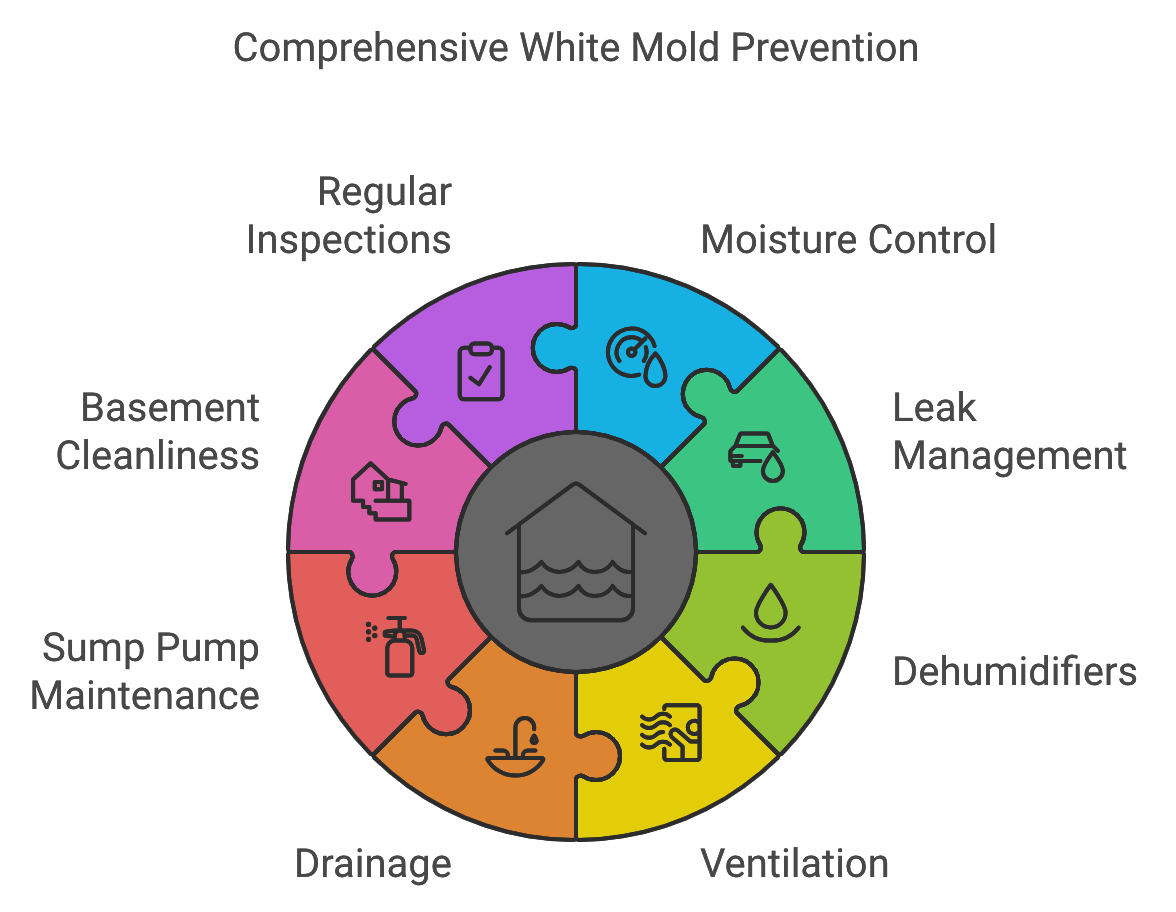Dealing With White Mold in Basement
White mold in your basement is more than just an eyesore—it can lead to health problems and structural damage if not addressed promptly. White mold refers to various types of mold that thrive in moist, enclosed spaces with organic food sources. Common types include Aspergillus, Penicillium, and Cladosporium. Although it may look similar to mildew or efflorescence, white mold can grow within porous surfaces like wood and drywall, causing potential harm. While mildew typically grows on plants and efflorescence is just a salt deposit that dissolves with water, white mold requires careful attention and testing to confirm.
How to Identify White Mold
White mold often appears as spots that look powdery, fluffy, stringy, or filmy. While it usually stays white, it can change color over time, which makes early detection challenging due to the tiny size of the spores. You might first notice a musty smell, discoloration, or condensation in areas where mold has taken hold. Basements are common places for white mold to grow due to their cool, damp environment and abundance of organic materials like wood and fabric.
Why Does White Mold Grow in Basements?
The primary driver behind mold growth is moisture. Basements, being below ground level, are naturally prone to condensation and leaks, whether from pipes, appliances, or the foundation itself. Mold also needs a food source, which is easily found in materials such as wood, drywall, carpeting, and fabric. Temperatures between 2°C and 40°C create an ideal climate for mold to thrive, making basements perfect breeding grounds.
How to Safely Remove White Mold
Click here for my favorite white mold remover
When dealing with white mold, safety is paramount. Always wear protective gear, including an N95 respirator, gloves, goggles, and coveralls. Make sure the area is well-ventilated while cleaning.

Depending on the size and severity of the infestation, you may use different cleaning solutions:
- Bleach: Effective on non-porous surfaces but not recommended for porous materials like wood and drywall.
- Vinegar: A natural, non-toxic solution that works well on hard surfaces.
- Borax: A natural cleaner that is effective but must be used correctly and kept away from ingestion.
- Hydrogen Peroxide: A safe, non-toxic option suitable for various surfaces.
- Concrobium: An EPA-approved mold solution that kills mold and prevents its return.
For hard surfaces, scrub with detergent and water, rinse, and dry thoroughly. Porous surfaces, like wood, may require light sanding before applying a cleaning solution. If mold covers a large area or causes health issues, it’s best to seek professional help to ensure safe and complete removal.
Preventing White Mold from Coming Back
Moisture control is key to preventing white mold. Address leaks promptly, use dehumidifiers, and enhance ventilation with exhaust fans or open windows. Ensuring proper drainage around your home is also essential—make sure the ground slopes away from the foundation, clean your gutters, and consider a French drain system if needed. Regularly maintain sump pumps to remove excess groundwater.
Keep your basement clean by avoiding storing organic materials like cardboard or paper directly on the floor and ensuring adequate air circulation around stored items. Also, regularly inspect your basement for musty smells, condensation, or signs of mold and clean areas that are prone to moisture.

Wrapping Up
Dealing with your basement’s white mold is crucial for your home’s structural integrity and your family’s health. Early identification, safe removal, and prevention are essential to keeping your home mold-free. Ignoring white mold can lead to worsening health problems and costly structural damage. For more detailed guidance, consult resources like the EPA’s mold remediation guide or consider professional mold services for large or persistent problems.
- Why Your Septic Tank Smells When It Rains (and What to Do About It)
- How to Handle Water-Damaged Wood in Your Home or Business
- How to Prevent and Remove Mold from Pillows: A Complete Guide
- Why Is My Carpet Always Wet? A Step-by-Step Guide to Identifying the Source of Moisture
- Signs of Septic System Failure and What It Means for Your Basement


